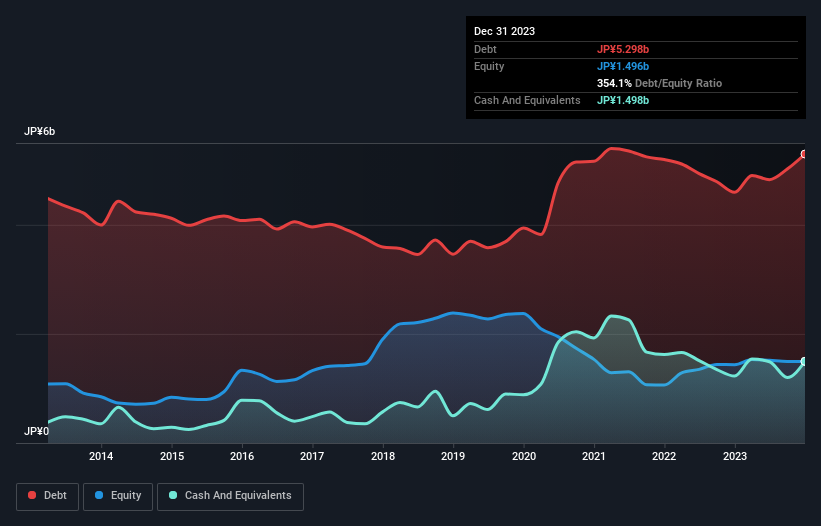Howard Marks put it nicely when he said that, rather than worrying about share price volatility, 'The possibility of permanent loss is the risk I worry about... and every practical investor I know worries about.' When we think about how risky a company is, we always like to look at its use of debt, since debt overload can lead to ruin. As with many other companies Okamoto Glass Co., Ltd. (TSE:7746) makes use of debt. But is this debt a concern to shareholders?
When Is Debt A Problem?
Debt assists a business until the business has trouble paying it off, either with new capital or with free cash flow. Ultimately, if the company can't fulfill its legal obligations to repay debt, shareholders could walk away with nothing. However, a more common (but still painful) scenario is that it has to raise new equity capital at a low price, thus permanently diluting shareholders. By replacing dilution, though, debt can be an extremely good tool for businesses that need capital to invest in growth at high rates of return. When we think about a company's use of debt, we first look at cash and debt together.
Check out our latest analysis for Okamoto Glass
What Is Okamoto Glass's Debt?
The image below, which you can click on for greater detail, shows that at December 2023 Okamoto Glass had debt of JP¥5.30b, up from JP¥4.60b in one year. However, because it has a cash reserve of JP¥1.50b, its net debt is less, at about JP¥3.80b.

A Look At Okamoto Glass' Liabilities
The latest balance sheet data shows that Okamoto Glass had liabilities of JP¥2.31b due within a year, and liabilities of JP¥4.15b falling due after that. Offsetting this, it had JP¥1.50b in cash and JP¥1.07b in receivables that were due within 12 months. So it has liabilities totalling JP¥3.89b more than its cash and near-term receivables, combined.
When you consider that this deficiency exceeds the company's JP¥3.40b market capitalization, you might well be inclined to review the balance sheet intently. In the scenario where the company had to clean up its balance sheet quickly, it seems likely shareholders would suffer extensive dilution. The balance sheet is clearly the area to focus on when you are analysing debt. But it is Okamoto Glass's earnings that will influence how the balance sheet holds up in the future. So when considering debt, it's definitely worth looking at the earnings trend. Click here for an interactive snapshot.
Over 12 months, Okamoto Glass made a loss at the EBIT level, and saw its revenue drop to JP¥4.1b, which is a fall of 22%. That makes us nervous, to say the least.
Caveat Emptor
Not only did Okamoto Glass's revenue slip over the last twelve months, but it also produced negative earnings before interest and tax (EBIT). To be specific the EBIT loss came in at JP¥110m. When we look at that alongside the significant liabilities, we're not particularly confident about the company. It would need to improve its operations quickly for us to be interested in it. Not least because it burned through JP¥346m in negative free cash flow over the last year. So suffice it to say we consider the stock to be risky. When analysing debt levels, the balance sheet is the obvious place to start. But ultimately, every company can contain risks that exist outside of the balance sheet. To that end, you should learn about the 4 warning signs we've spotted with Okamoto Glass (including 1 which doesn't sit too well with us) .
Of course, if you're the type of investor who prefers buying stocks without the burden of debt, then don't hesitate to discover our exclusive list of net cash growth stocks, today.
New: AI Stock Screener & Alerts
Our new AI Stock Screener scans the market every day to uncover opportunities.
• Dividend Powerhouses (3%+ Yield)
• Undervalued Small Caps with Insider Buying
• High growth Tech and AI Companies
Or build your own from over 50 metrics.
Have feedback on this article? Concerned about the content? Get in touch with us directly. Alternatively, email editorial-team (at) simplywallst.com.
This article by Simply Wall St is general in nature. We provide commentary based on historical data and analyst forecasts only using an unbiased methodology and our articles are not intended to be financial advice. It does not constitute a recommendation to buy or sell any stock, and does not take account of your objectives, or your financial situation. We aim to bring you long-term focused analysis driven by fundamental data. Note that our analysis may not factor in the latest price-sensitive company announcements or qualitative material. Simply Wall St has no position in any stocks mentioned.
About TSE:7746
Okamoto Glass
Manufactures and sells special-purpose glass for industrial use and multi-layer film evaporation products.
Imperfect balance sheet with very low risk.
Market Insights
Community Narratives



